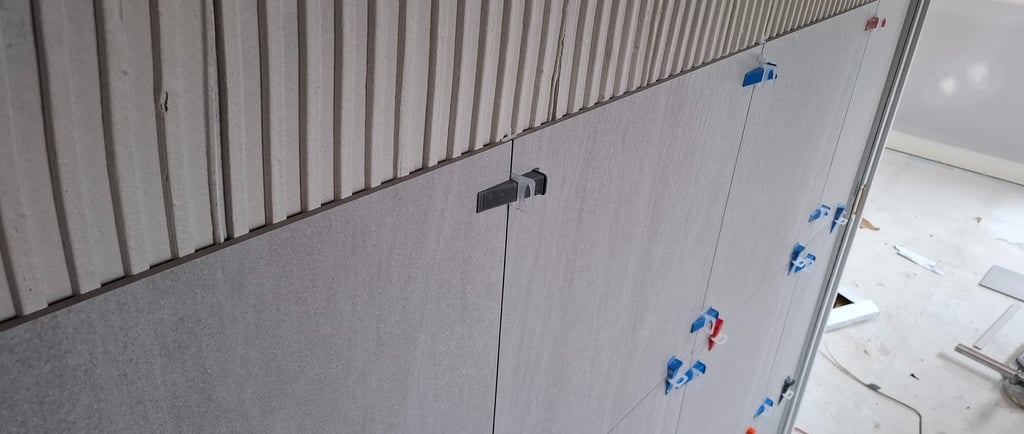Exploring the Benefits of Porcelain Wall and Floor Tiles: Strength, Design Versatility, and Water Resistance
9/25/20254 min read


The Strength of Porcelain Tiles
Porcelain tiles are renowned for their significant strength, making them a preferred choice for various applications, including both wall and floor coverings. Their inherent density and durability set them apart from other tile types, such as ceramic or vinyl. The strength of porcelain tiles is primarily attributed to the materials used in their manufacturing process, which often includes kaolin clay, feldspar, and other natural minerals. These materials are subjected to extremely high temperatures during firing, resulting in a denser and tougher product compared to standard ceramic tiles.
A key characteristic of porcelain tiles is their remarkable resistance to chipping, cracking, and scratching, which is an essential factor to consider, particularly for high-traffic areas. Unlike softer tile options, porcelain maintains its aesthetic appeal even after years of use, thanks to its resilient surface. For instance, commercial spaces such as hotels and shopping centers often utilize porcelain tiles due to their ability to withstand heavy foot traffic without showing wear and tear. Homeowners can benefit from this strength as well, especially in areas prone to spills or heavy movement, such as kitchens and entryways.
In addition to their physical properties, expert opinions frequently highlight porcelain tiles' longevity. Industry professionals often recommend them for both residential and commercial settings, citing their ability to maintain structural integrity over time. A study performed by industry experts analyzed the performance of various tile materials, resulting in porcelain tiles being recognized for their resistance to environmental factors, such as moisture and temperature changes. This performance further underscores the advantages of selecting porcelain tiles for flooring or wall applications.
Through advanced manufacturing techniques and the use of high-quality materials, porcelain tiles exhibit strength and durability that meet the needs of diverse environments, making them a reliable and stylish choice.
Design Versatility of Porcelain Tiles
Porcelain tiles stand out in the realm of flooring and wall coverings due to their exceptional design versatility. Available in a wide spectrum of styles, colors, and finishes, these tiles can cater to an array of tastes and preferences. Homeowners and designers alike appreciate that porcelain can effectively mimic natural materials such as wood and stone, offering a sophisticated and realistic appearance without the maintenance challenges associated with these materials. This quality enables porcelain tiles to be seamlessly integrated into both modern and traditional design settings.
For contemporary spaces, sleek, glossy finishes in neutral tones can create an atmosphere of minimalism and elegance. Conversely, matte porcelain tiles with earthier hues may enhance traditional or rustic interiors, grounding the space with natural warmth. Thanks to advancements in printing technology, porcelain tiles now come in intricate patterns, ranging from geometric designs to soft textures, further expanding their application across various design themes.
When selecting porcelain tiles for a project, it is crucial to consider both aesthetic and functional requirements. High-traffic areas may benefit from tiles with a textured surface for added slip resistance and durability, while softer, polished finishes might be more appropriate for low-traffic or formal settings. Additionally, coordinating tile sizes and layouts can create innovative designs, such as large format tiles that reduce grout lines and enhance visual continuity in a space.
Incorporating porcelain tiles into both interior and exterior design not only elevates the visual appeal of a space but also aligns with practical considerations, allowing for creativity without compromising on functionality. This remarkable adaptability is one of the core advantages of porcelain tiles, making them an ideal choice for diverse design projects.
Water Resistance: Why It Matters
Porcelain tiles are renowned for their exceptional water resistance, making them an ideal choice for various applications, particularly in moisture-prone environments such as kitchens and bathrooms. The water-resistant properties of porcelain stem from its manufacturing process, where clay is fired at high temperatures. This process results in a dense, robust material with extremely low water absorption rates—typically less than 0.5%. This characteristic not only helps to prevent water infiltration but also minimizes the risk of damage or degradation, ensuring the longevity of both wall and floor installations.
The implications of using water-resistant porcelain tiles in moisture-laden areas are significant. For bathrooms, where splashes and spills are commonplace, the use of porcelain means that the tiles are less likely to develop mold or mildew, which can be detrimental to both health and aesthetics. In kitchens, porcelain tiles can withstand spills and splatters, providing a surface that is not only easy to clean but also resilient against stains and odors that often accompany food preparation activities. Therefore, the incorporation of porcelain tiles in these spaces contributes to a cleaner and more hygienic environment.
To ensure that water-resistant porcelain tiles maintain their performance and appearance over time, regular maintenance is essential. Simple practices such as promptly cleaning up spills, using non-abrasive cleaning solutions, and avoiding harsh chemicals can help preserve the integrity of the tiles. Furthermore, sealing the grout lines between tiles can provide an extra layer of protection against water infiltration, prolonging the life of the installation. With these considerations in mind, opting for porcelain tiles can enhance the durability and functionality of your spaces, reinforcing their value as a long-term investment in home improvement.
Expert Insights for Choosing the Best Porcelain Tiles
Selecting the most suitable porcelain tiles for your project requires careful consideration of several crucial factors. One of the primary considerations is the size of the tiles. Larger tiles can create a more spacious appearance and fewer grout lines, enhancing the visual appeal in areas such as living rooms and open spaces. Conversely, smaller tiles may be more advantageous in intricate designs or smaller areas, allowing for greater versatility in layout and design.
The finish of the tiles is another significant aspect to examine. Porcelain tiles come in a variety of finishes, including matte, glossy, and textured surfaces. Glossy finishes can add a touch of elegance but might pose challenges in terms of slip resistance, especially in wet areas such as bathrooms and kitchens. On the other hand, textured tiles can increase traction, making them ideal for outdoor spaces or areas that may be exposed to moisture.
Slip resistance is a critical factor, particularly in environments where safety is a priority. Tiles are rated on a scale for their slip resistance, with higher ratings indicating better performance in preventing slips and falls. This is an essential consideration for both homes and commercial spaces, notably in areas with high foot traffic or exposure to water.
Additionally, it’s important to consider the specific environment where the tiles will be installed. Factors such as moisture levels, heating methods, and foot traffic can significantly impact the choice of porcelain tiles. For example, high moisture areas necessitate water-resistant tiles, while tiles used in high-traffic areas should have enhanced durability.
To aid in the decision-making process, a checklist can be beneficial. Focus on size, finish, slip resistance, and suitability for different environments. By prioritizing these elements, homeowners and designers can select porcelain tiles that not only meet aesthetic preferences but also align with functional requirements and budget constraints.
